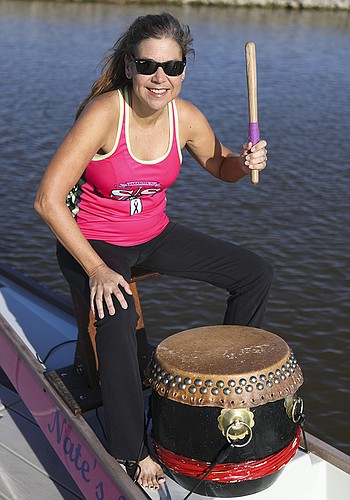- November 24, 2024
-
-
Loading

Loading

Executive: Paula Murray, principal at Artefact Design in Sarasota, a graphic design firm founded in 1994 that works primarily with nonprofits, including the Sarasota Museum of Modern Art and Marie Selby Botanical Gardens.
Diversion: Dragon boating. The sport began in China centuries ago, gained popularity in Canada and Australia in more recent times, and is now starting to take off in the United States.
Support system: Murray's been a member of Survivors in Sync, a team of breast cancer survivors based at Nathan Benderson Park in Sarasota, since 2014. “It's based on joining a terrible club,” says Murray, who's been in remission for 10 years. “We're all at different stages and have different diagnoses. We sometimes talk about them as we're getting ready to get on the boat, but once we're on the boat, we're athletes. We're survivors on the land and athletes on the water.”
No experience necessary: Murray never considered herself to be all that athletic, and she's not especially comfortable on the water. “But the moment I got on the boat, it was transformational,” she says. “There's something about the combination of being in sync with other people in a physical way and being on the water, which can be so beautiful. It's like your blood pressure lowers the moment you get on.”
Switch up: Murray started out paddling on the left side of the boat because she's left-handed. But after about a year, the team needed someone on the right side, so she gave it a go. “It was really awkward at first,” she says. “But I found that I'm good at it in a different way. On the left, my left hand is on the bottom, and I have a better sense of control. When I'm on the right side, I have more power on my top hand, so I can dig in harder.”
Surprise benefits: Murray expected dragon boating to be all about upper-body training, but she's found that it incorporates many more muscle groups. “You're pushing against a bar with your legs to bring your stroke up,” she says. “You're using your core, and you're twisting your core. So it's really a full-body workout.”
All about efficiency: Murray considers herself a problem solver in her professional and paddling life. “For me, it's just trying to figure out how to do subtle, incremental improvements,” she says. “What is the little tiny thing that can get us one second more in a race, because our races really come down to seconds.” Because that includes things like getting weight out of the boat, she doesn't wear shoes when dragon boating. “That's an extra half a pound,” she says. “Plus, I prefer to feel the water under the boat. I'm more tactile, I guess.”
Off the water: The team practices three days a week at Nathan Benderson Park. When team members aren't in the boat, they hit the gym to strengthen what they're doing on the water. “Obviously a rowing machine is really useful,” says Murray. “Even though it's a different motion, you're using the same muscles.” The team, which ranges in age from mid-40s to mid-70s, has also recently started working with a sports massage therapist to learn how to prevent injury and pain.
Looking ahead: After just five months on the team, Murray competed in the 2014 International Breast Cancer Paddlers' Commission Festival, which was held at Nathan Benderson Park.
Now, Survivors in Sync is gearing up for the 2018 festival in Florence, Italy. The team finished in the middle of the pack in 2014, and Murray has loftier goals for 2018. “I want to get in the top 10,” she says. “I want to give the top teams a run for their money, so we'll see how that goes.”
Model behavior: Murray's proud of the example she's setting for her two teenage children. “It's good for them to see that you can try something that you don't know how to do and be open to being bad at it and working at being better at it,” she says. “I'm hoping that it puts a little reminder to them that if something comes up that they're interested in, they might say, 'I can probably hang for a bit to see if I like it and can get better at it.'”